Financial Management Report: Case Analysis of Nursing Service Plan
VerifiedAdded on 2022/09/29
|17
|4370
|16
Report
AI Summary
This report presents a financial management plan for a nursing service, addressing key areas such as business plan development, potential steps for service improvement, required documents, and service demand analysis. It delves into workload methodology, staff requirements, skill-mix considerations, and the benefits of cost center budgeting. The report explores various budgeting methods, including zero-based budgeting, and provides a sample salaries and wages budget. The introduction outlines the importance of a well-structured business plan in the context of a hospital's general surgical ward. The report also emphasizes assessment, diagnosis, outcome, planning, implementation, and evaluation processes. Furthermore, it discusses the crucial role of documents like healthcare proxy, living will, and HIPAA forms in service delivery. The discussion on staff requirements covers acuity-quality methodology, skill-mix, and the legal framework governing healthcare practices. The conclusion summarizes the importance of financial planning and efficient resource allocation in healthcare management.

Running head: FINANCIAL MANAGEMENT
Financial Management
Financial Management
Paraphrase This Document
Need a fresh take? Get an instant paraphrase of this document with our AI Paraphraser
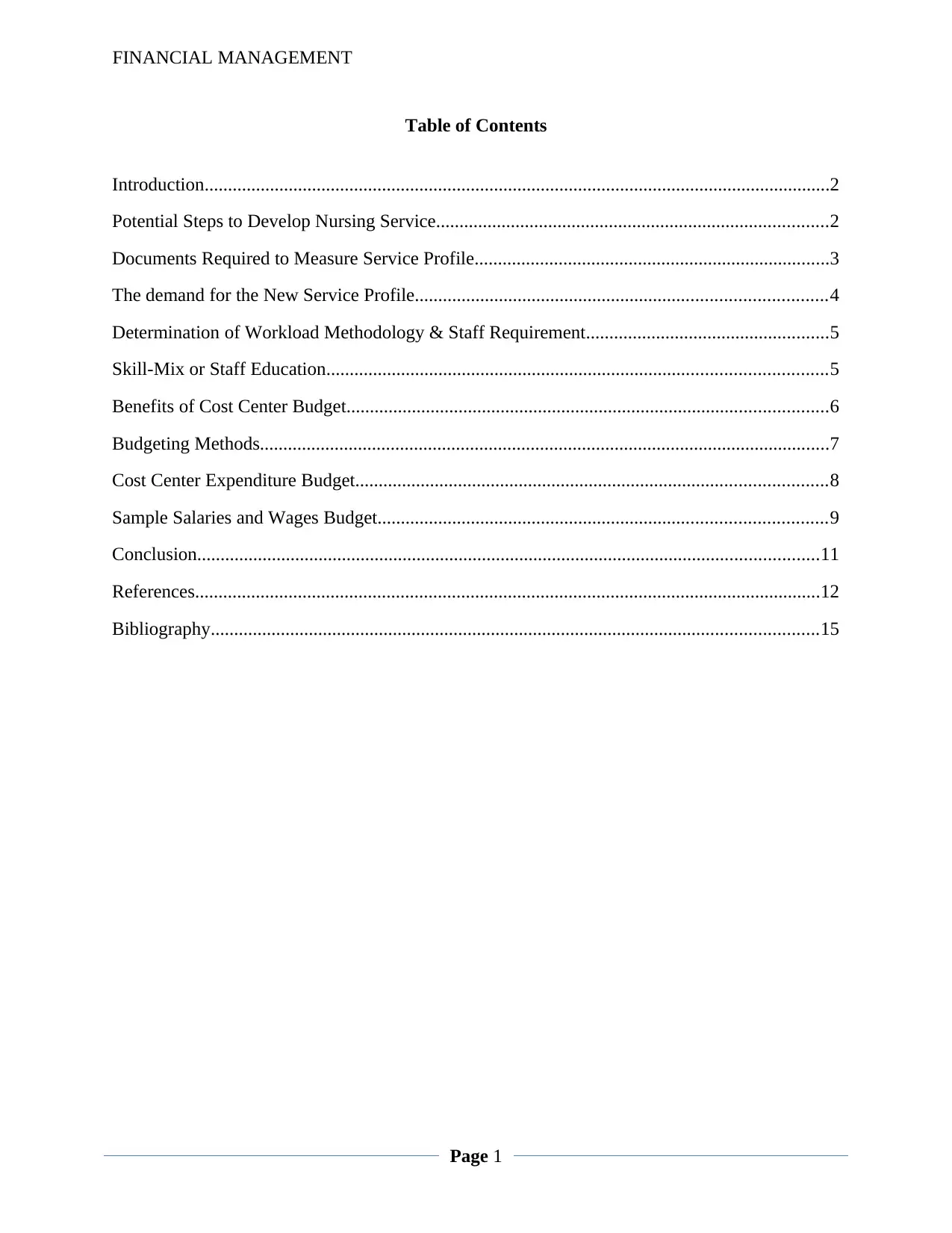
FINANCIAL MANAGEMENT
Table of Contents
Introduction......................................................................................................................................2
Potential Steps to Develop Nursing Service....................................................................................2
Documents Required to Measure Service Profile............................................................................3
The demand for the New Service Profile........................................................................................4
Determination of Workload Methodology & Staff Requirement....................................................5
Skill-Mix or Staff Education...........................................................................................................5
Benefits of Cost Center Budget.......................................................................................................6
Budgeting Methods..........................................................................................................................7
Cost Center Expenditure Budget.....................................................................................................8
Sample Salaries and Wages Budget................................................................................................9
Conclusion.....................................................................................................................................11
References......................................................................................................................................12
Bibliography..................................................................................................................................15
Page 1
Table of Contents
Introduction......................................................................................................................................2
Potential Steps to Develop Nursing Service....................................................................................2
Documents Required to Measure Service Profile............................................................................3
The demand for the New Service Profile........................................................................................4
Determination of Workload Methodology & Staff Requirement....................................................5
Skill-Mix or Staff Education...........................................................................................................5
Benefits of Cost Center Budget.......................................................................................................6
Budgeting Methods..........................................................................................................................7
Cost Center Expenditure Budget.....................................................................................................8
Sample Salaries and Wages Budget................................................................................................9
Conclusion.....................................................................................................................................11
References......................................................................................................................................12
Bibliography..................................................................................................................................15
Page 1
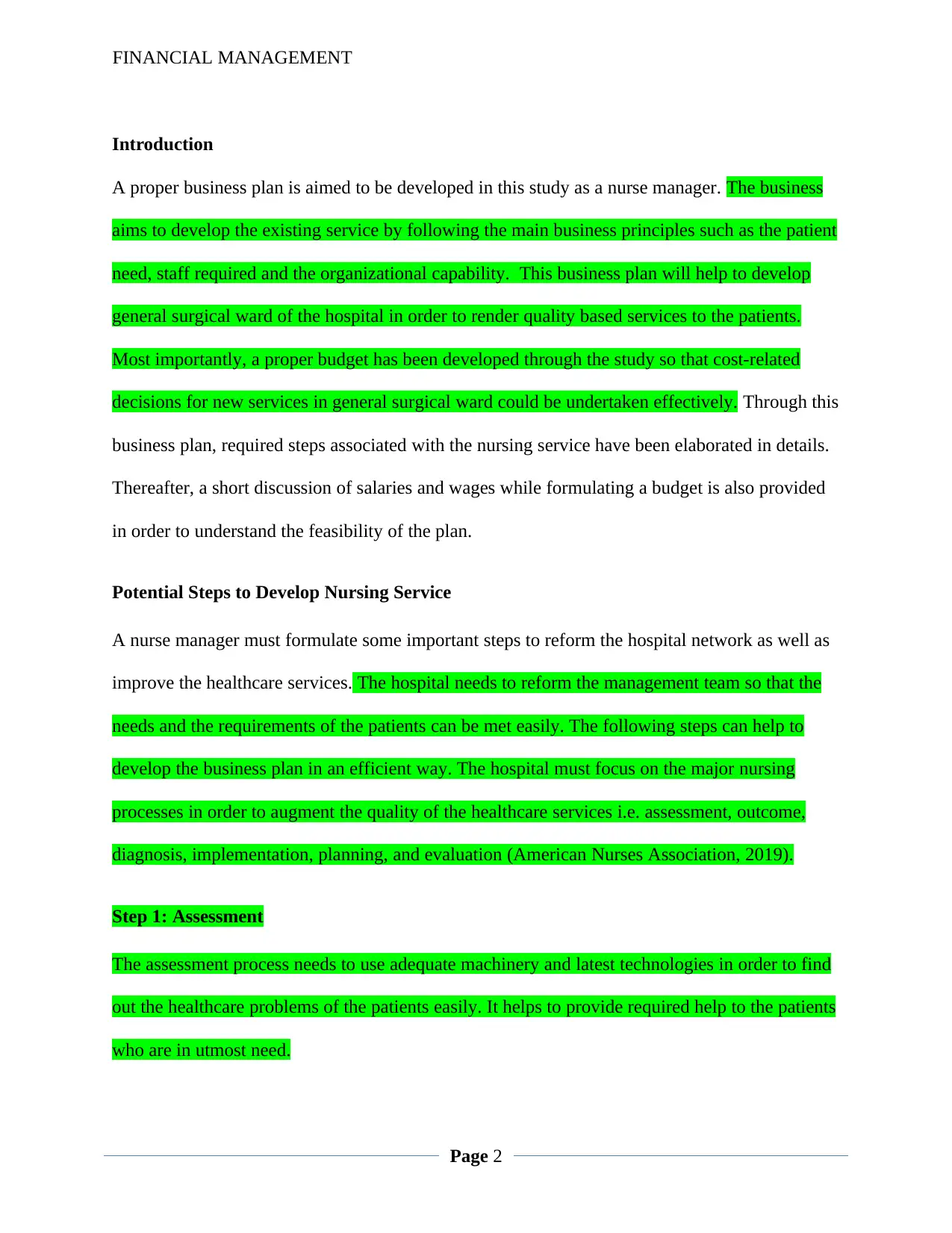
FINANCIAL MANAGEMENT
Introduction
A proper business plan is aimed to be developed in this study as a nurse manager. The business
aims to develop the existing service by following the main business principles such as the patient
need, staff required and the organizational capability. This business plan will help to develop
general surgical ward of the hospital in order to render quality based services to the patients.
Most importantly, a proper budget has been developed through the study so that cost-related
decisions for new services in general surgical ward could be undertaken effectively. Through this
business plan, required steps associated with the nursing service have been elaborated in details.
Thereafter, a short discussion of salaries and wages while formulating a budget is also provided
in order to understand the feasibility of the plan.
Potential Steps to Develop Nursing Service
A nurse manager must formulate some important steps to reform the hospital network as well as
improve the healthcare services. The hospital needs to reform the management team so that the
needs and the requirements of the patients can be met easily. The following steps can help to
develop the business plan in an efficient way. The hospital must focus on the major nursing
processes in order to augment the quality of the healthcare services i.e. assessment, outcome,
diagnosis, implementation, planning, and evaluation (American Nurses Association, 2019).
Step 1: Assessment
The assessment process needs to use adequate machinery and latest technologies in order to find
out the healthcare problems of the patients easily. It helps to provide required help to the patients
who are in utmost need.
Page 2
Introduction
A proper business plan is aimed to be developed in this study as a nurse manager. The business
aims to develop the existing service by following the main business principles such as the patient
need, staff required and the organizational capability. This business plan will help to develop
general surgical ward of the hospital in order to render quality based services to the patients.
Most importantly, a proper budget has been developed through the study so that cost-related
decisions for new services in general surgical ward could be undertaken effectively. Through this
business plan, required steps associated with the nursing service have been elaborated in details.
Thereafter, a short discussion of salaries and wages while formulating a budget is also provided
in order to understand the feasibility of the plan.
Potential Steps to Develop Nursing Service
A nurse manager must formulate some important steps to reform the hospital network as well as
improve the healthcare services. The hospital needs to reform the management team so that the
needs and the requirements of the patients can be met easily. The following steps can help to
develop the business plan in an efficient way. The hospital must focus on the major nursing
processes in order to augment the quality of the healthcare services i.e. assessment, outcome,
diagnosis, implementation, planning, and evaluation (American Nurses Association, 2019).
Step 1: Assessment
The assessment process needs to use adequate machinery and latest technologies in order to find
out the healthcare problems of the patients easily. It helps to provide required help to the patients
who are in utmost need.
Page 2
⊘ This is a preview!⊘
Do you want full access?
Subscribe today to unlock all pages.

Trusted by 1+ million students worldwide
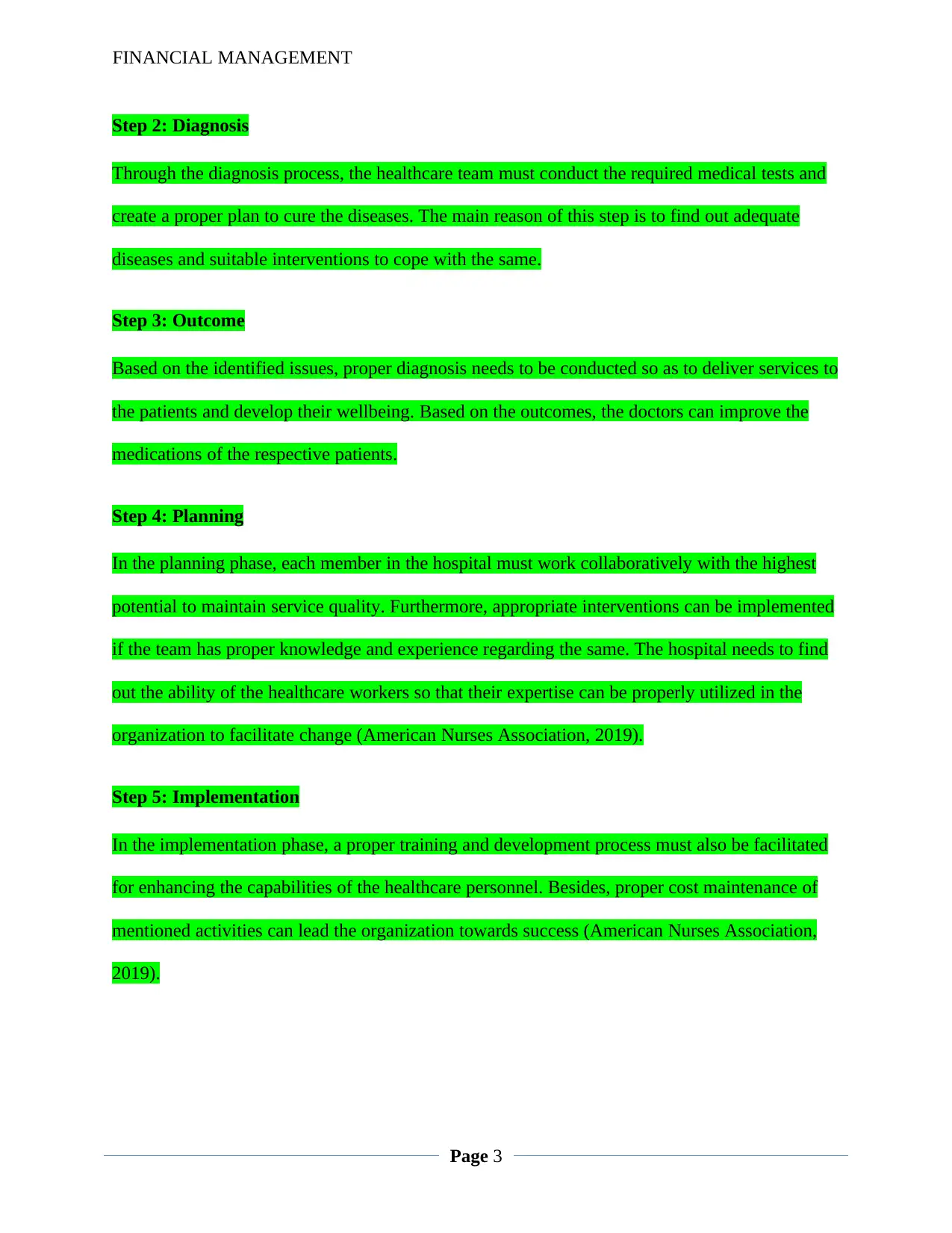
FINANCIAL MANAGEMENT
Step 2: Diagnosis
Through the diagnosis process, the healthcare team must conduct the required medical tests and
create a proper plan to cure the diseases. The main reason of this step is to find out adequate
diseases and suitable interventions to cope with the same.
Step 3: Outcome
Based on the identified issues, proper diagnosis needs to be conducted so as to deliver services to
the patients and develop their wellbeing. Based on the outcomes, the doctors can improve the
medications of the respective patients.
Step 4: Planning
In the planning phase, each member in the hospital must work collaboratively with the highest
potential to maintain service quality. Furthermore, appropriate interventions can be implemented
if the team has proper knowledge and experience regarding the same. The hospital needs to find
out the ability of the healthcare workers so that their expertise can be properly utilized in the
organization to facilitate change (American Nurses Association, 2019).
Step 5: Implementation
In the implementation phase, a proper training and development process must also be facilitated
for enhancing the capabilities of the healthcare personnel. Besides, proper cost maintenance of
mentioned activities can lead the organization towards success (American Nurses Association,
2019).
Page 3
Step 2: Diagnosis
Through the diagnosis process, the healthcare team must conduct the required medical tests and
create a proper plan to cure the diseases. The main reason of this step is to find out adequate
diseases and suitable interventions to cope with the same.
Step 3: Outcome
Based on the identified issues, proper diagnosis needs to be conducted so as to deliver services to
the patients and develop their wellbeing. Based on the outcomes, the doctors can improve the
medications of the respective patients.
Step 4: Planning
In the planning phase, each member in the hospital must work collaboratively with the highest
potential to maintain service quality. Furthermore, appropriate interventions can be implemented
if the team has proper knowledge and experience regarding the same. The hospital needs to find
out the ability of the healthcare workers so that their expertise can be properly utilized in the
organization to facilitate change (American Nurses Association, 2019).
Step 5: Implementation
In the implementation phase, a proper training and development process must also be facilitated
for enhancing the capabilities of the healthcare personnel. Besides, proper cost maintenance of
mentioned activities can lead the organization towards success (American Nurses Association,
2019).
Page 3
Paraphrase This Document
Need a fresh take? Get an instant paraphrase of this document with our AI Paraphraser
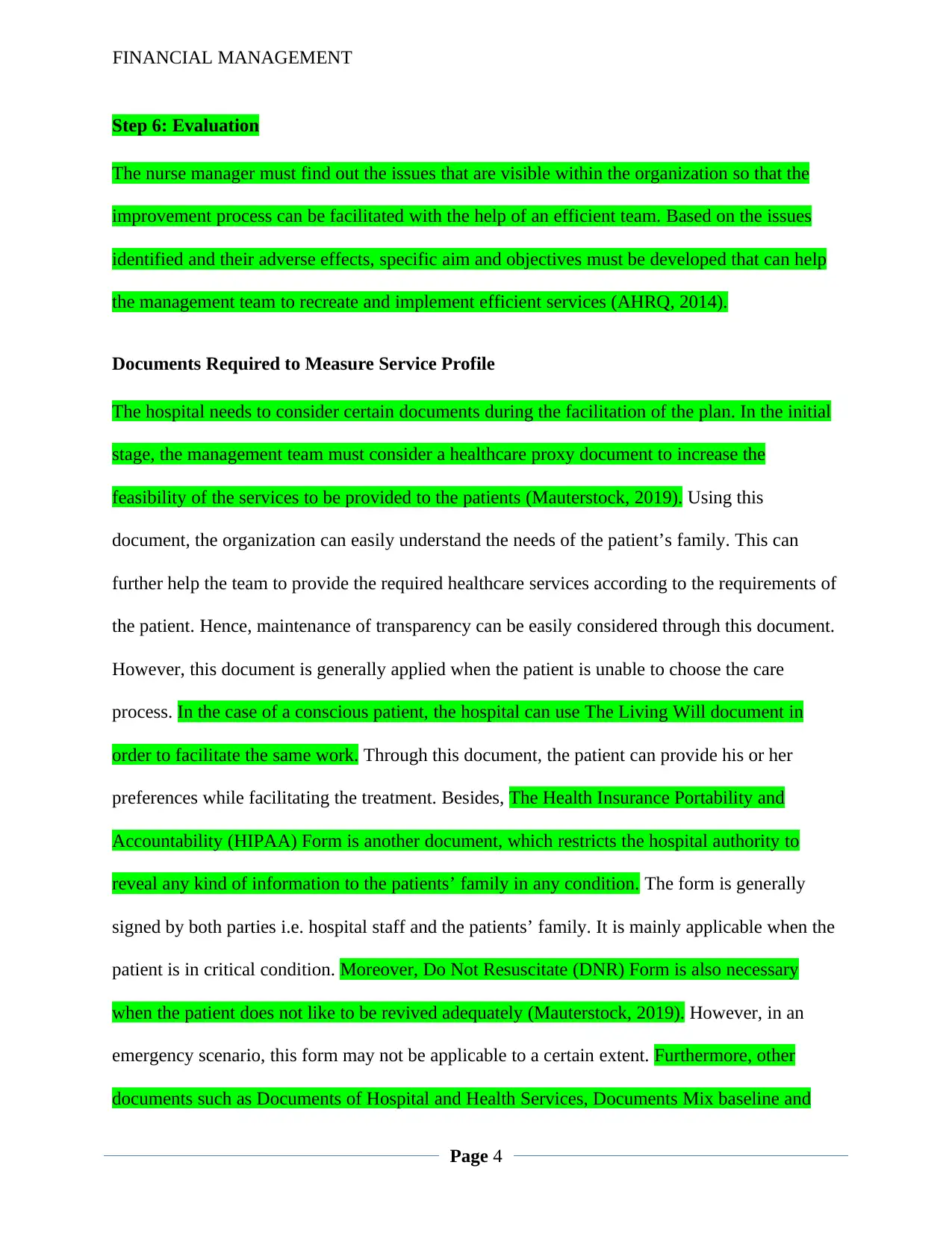
FINANCIAL MANAGEMENT
Step 6: Evaluation
The nurse manager must find out the issues that are visible within the organization so that the
improvement process can be facilitated with the help of an efficient team. Based on the issues
identified and their adverse effects, specific aim and objectives must be developed that can help
the management team to recreate and implement efficient services (AHRQ, 2014).
Documents Required to Measure Service Profile
The hospital needs to consider certain documents during the facilitation of the plan. In the initial
stage, the management team must consider a healthcare proxy document to increase the
feasibility of the services to be provided to the patients (Mauterstock, 2019). Using this
document, the organization can easily understand the needs of the patient’s family. This can
further help the team to provide the required healthcare services according to the requirements of
the patient. Hence, maintenance of transparency can be easily considered through this document.
However, this document is generally applied when the patient is unable to choose the care
process. In the case of a conscious patient, the hospital can use The Living Will document in
order to facilitate the same work. Through this document, the patient can provide his or her
preferences while facilitating the treatment. Besides, The Health Insurance Portability and
Accountability (HIPAA) Form is another document, which restricts the hospital authority to
reveal any kind of information to the patients’ family in any condition. The form is generally
signed by both parties i.e. hospital staff and the patients’ family. It is mainly applicable when the
patient is in critical condition. Moreover, Do Not Resuscitate (DNR) Form is also necessary
when the patient does not like to be revived adequately (Mauterstock, 2019). However, in an
emergency scenario, this form may not be applicable to a certain extent. Furthermore, other
documents such as Documents of Hospital and Health Services, Documents Mix baseline and
Page 4
Step 6: Evaluation
The nurse manager must find out the issues that are visible within the organization so that the
improvement process can be facilitated with the help of an efficient team. Based on the issues
identified and their adverse effects, specific aim and objectives must be developed that can help
the management team to recreate and implement efficient services (AHRQ, 2014).
Documents Required to Measure Service Profile
The hospital needs to consider certain documents during the facilitation of the plan. In the initial
stage, the management team must consider a healthcare proxy document to increase the
feasibility of the services to be provided to the patients (Mauterstock, 2019). Using this
document, the organization can easily understand the needs of the patient’s family. This can
further help the team to provide the required healthcare services according to the requirements of
the patient. Hence, maintenance of transparency can be easily considered through this document.
However, this document is generally applied when the patient is unable to choose the care
process. In the case of a conscious patient, the hospital can use The Living Will document in
order to facilitate the same work. Through this document, the patient can provide his or her
preferences while facilitating the treatment. Besides, The Health Insurance Portability and
Accountability (HIPAA) Form is another document, which restricts the hospital authority to
reveal any kind of information to the patients’ family in any condition. The form is generally
signed by both parties i.e. hospital staff and the patients’ family. It is mainly applicable when the
patient is in critical condition. Moreover, Do Not Resuscitate (DNR) Form is also necessary
when the patient does not like to be revived adequately (Mauterstock, 2019). However, in an
emergency scenario, this form may not be applicable to a certain extent. Furthermore, other
documents such as Documents of Hospital and Health Services, Documents Mix baseline and
Page 4
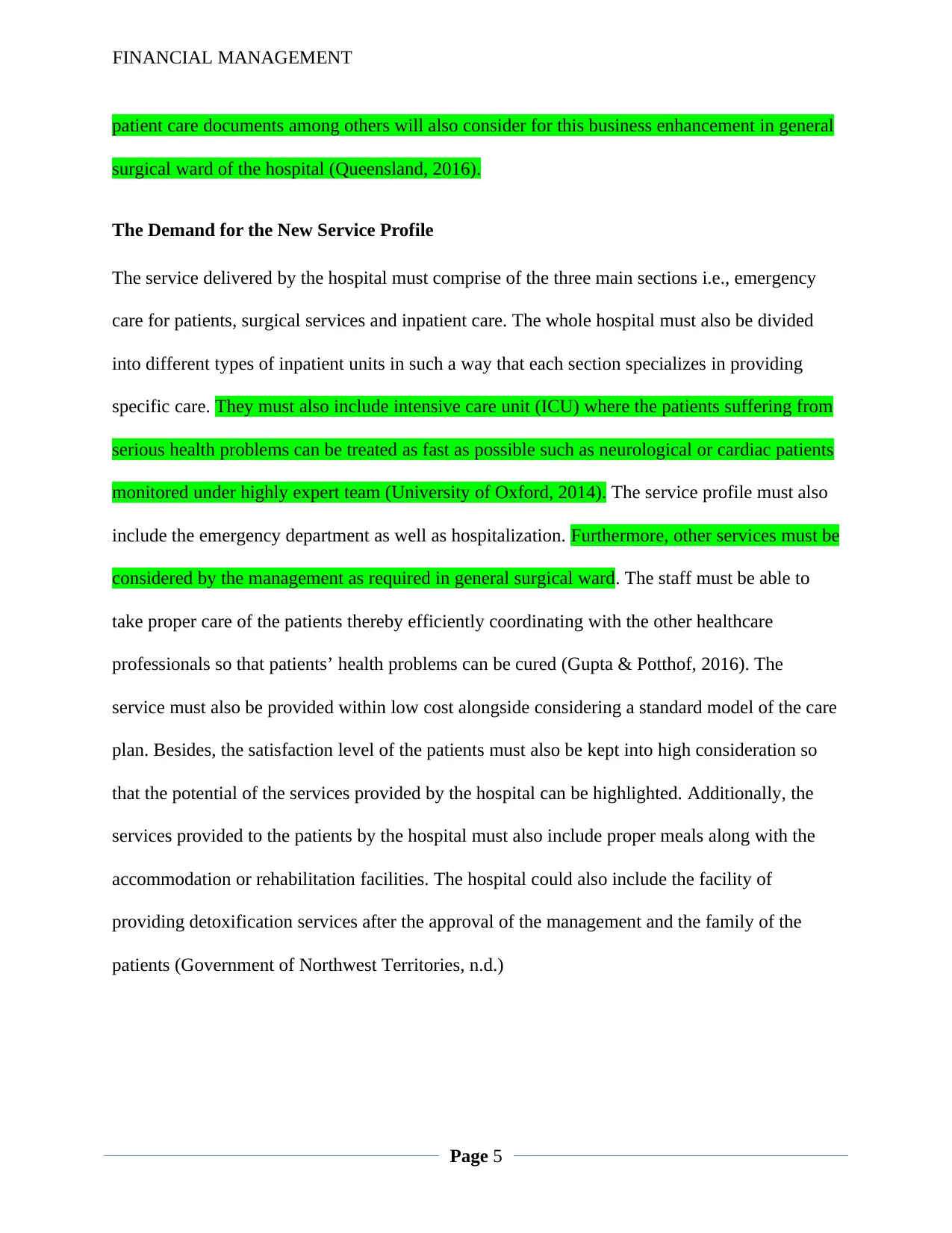
FINANCIAL MANAGEMENT
patient care documents among others will also consider for this business enhancement in general
surgical ward of the hospital (Queensland, 2016).
The Demand for the New Service Profile
The service delivered by the hospital must comprise of the three main sections i.e., emergency
care for patients, surgical services and inpatient care. The whole hospital must also be divided
into different types of inpatient units in such a way that each section specializes in providing
specific care. They must also include intensive care unit (ICU) where the patients suffering from
serious health problems can be treated as fast as possible such as neurological or cardiac patients
monitored under highly expert team (University of Oxford, 2014). The service profile must also
include the emergency department as well as hospitalization. Furthermore, other services must be
considered by the management as required in general surgical ward. The staff must be able to
take proper care of the patients thereby efficiently coordinating with the other healthcare
professionals so that patients’ health problems can be cured (Gupta & Potthof, 2016). The
service must also be provided within low cost alongside considering a standard model of the care
plan. Besides, the satisfaction level of the patients must also be kept into high consideration so
that the potential of the services provided by the hospital can be highlighted. Additionally, the
services provided to the patients by the hospital must also include proper meals along with the
accommodation or rehabilitation facilities. The hospital could also include the facility of
providing detoxification services after the approval of the management and the family of the
patients (Government of Northwest Territories, n.d.)
Page 5
patient care documents among others will also consider for this business enhancement in general
surgical ward of the hospital (Queensland, 2016).
The Demand for the New Service Profile
The service delivered by the hospital must comprise of the three main sections i.e., emergency
care for patients, surgical services and inpatient care. The whole hospital must also be divided
into different types of inpatient units in such a way that each section specializes in providing
specific care. They must also include intensive care unit (ICU) where the patients suffering from
serious health problems can be treated as fast as possible such as neurological or cardiac patients
monitored under highly expert team (University of Oxford, 2014). The service profile must also
include the emergency department as well as hospitalization. Furthermore, other services must be
considered by the management as required in general surgical ward. The staff must be able to
take proper care of the patients thereby efficiently coordinating with the other healthcare
professionals so that patients’ health problems can be cured (Gupta & Potthof, 2016). The
service must also be provided within low cost alongside considering a standard model of the care
plan. Besides, the satisfaction level of the patients must also be kept into high consideration so
that the potential of the services provided by the hospital can be highlighted. Additionally, the
services provided to the patients by the hospital must also include proper meals along with the
accommodation or rehabilitation facilities. The hospital could also include the facility of
providing detoxification services after the approval of the management and the family of the
patients (Government of Northwest Territories, n.d.)
Page 5
⊘ This is a preview!⊘
Do you want full access?
Subscribe today to unlock all pages.

Trusted by 1+ million students worldwide
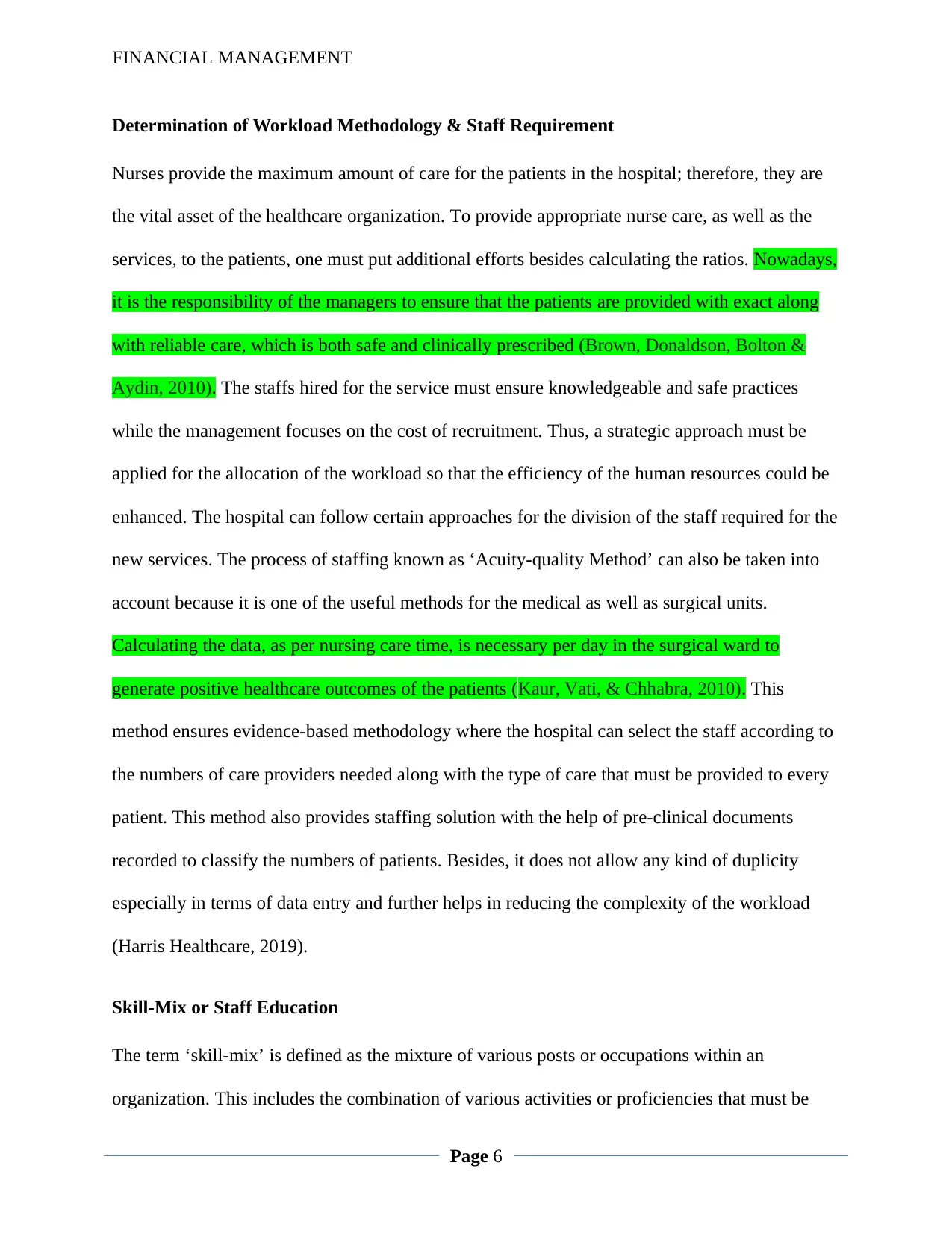
FINANCIAL MANAGEMENT
Determination of Workload Methodology & Staff Requirement
Nurses provide the maximum amount of care for the patients in the hospital; therefore, they are
the vital asset of the healthcare organization. To provide appropriate nurse care, as well as the
services, to the patients, one must put additional efforts besides calculating the ratios. Nowadays,
it is the responsibility of the managers to ensure that the patients are provided with exact along
with reliable care, which is both safe and clinically prescribed (Brown, Donaldson, Bolton &
Aydin, 2010). The staffs hired for the service must ensure knowledgeable and safe practices
while the management focuses on the cost of recruitment. Thus, a strategic approach must be
applied for the allocation of the workload so that the efficiency of the human resources could be
enhanced. The hospital can follow certain approaches for the division of the staff required for the
new services. The process of staffing known as ‘Acuity-quality Method’ can also be taken into
account because it is one of the useful methods for the medical as well as surgical units.
Calculating the data, as per nursing care time, is necessary per day in the surgical ward to
generate positive healthcare outcomes of the patients (Kaur, Vati, & Chhabra, 2010). This
method ensures evidence-based methodology where the hospital can select the staff according to
the numbers of care providers needed along with the type of care that must be provided to every
patient. This method also provides staffing solution with the help of pre-clinical documents
recorded to classify the numbers of patients. Besides, it does not allow any kind of duplicity
especially in terms of data entry and further helps in reducing the complexity of the workload
(Harris Healthcare, 2019).
Skill-Mix or Staff Education
The term ‘skill-mix’ is defined as the mixture of various posts or occupations within an
organization. This includes the combination of various activities or proficiencies that must be
Page 6
Determination of Workload Methodology & Staff Requirement
Nurses provide the maximum amount of care for the patients in the hospital; therefore, they are
the vital asset of the healthcare organization. To provide appropriate nurse care, as well as the
services, to the patients, one must put additional efforts besides calculating the ratios. Nowadays,
it is the responsibility of the managers to ensure that the patients are provided with exact along
with reliable care, which is both safe and clinically prescribed (Brown, Donaldson, Bolton &
Aydin, 2010). The staffs hired for the service must ensure knowledgeable and safe practices
while the management focuses on the cost of recruitment. Thus, a strategic approach must be
applied for the allocation of the workload so that the efficiency of the human resources could be
enhanced. The hospital can follow certain approaches for the division of the staff required for the
new services. The process of staffing known as ‘Acuity-quality Method’ can also be taken into
account because it is one of the useful methods for the medical as well as surgical units.
Calculating the data, as per nursing care time, is necessary per day in the surgical ward to
generate positive healthcare outcomes of the patients (Kaur, Vati, & Chhabra, 2010). This
method ensures evidence-based methodology where the hospital can select the staff according to
the numbers of care providers needed along with the type of care that must be provided to every
patient. This method also provides staffing solution with the help of pre-clinical documents
recorded to classify the numbers of patients. Besides, it does not allow any kind of duplicity
especially in terms of data entry and further helps in reducing the complexity of the workload
(Harris Healthcare, 2019).
Skill-Mix or Staff Education
The term ‘skill-mix’ is defined as the mixture of various posts or occupations within an
organization. This includes the combination of various activities or proficiencies that must be
Page 6
Paraphrase This Document
Need a fresh take? Get an instant paraphrase of this document with our AI Paraphraser
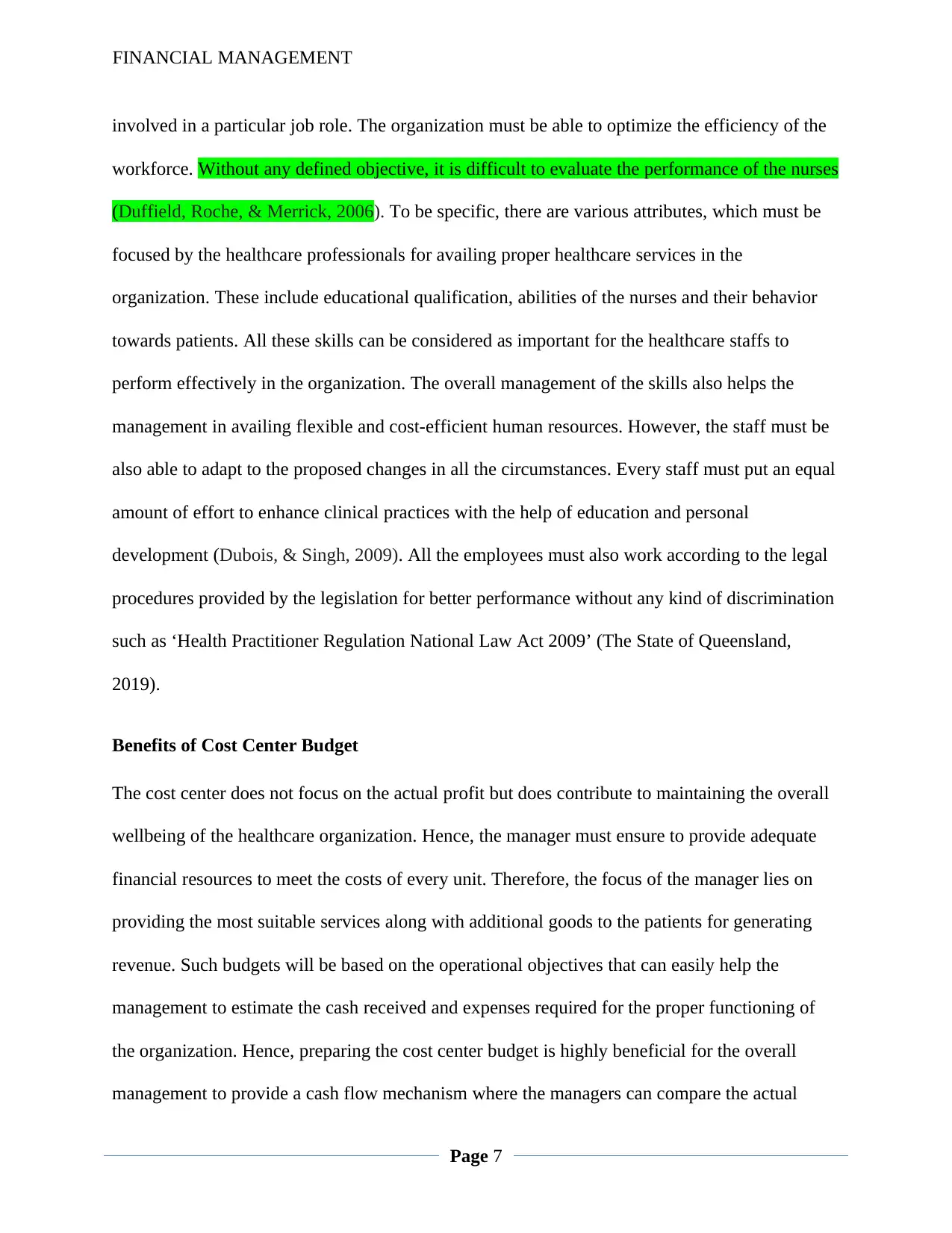
FINANCIAL MANAGEMENT
involved in a particular job role. The organization must be able to optimize the efficiency of the
workforce. Without any defined objective, it is difficult to evaluate the performance of the nurses
(Duffield, Roche, & Merrick, 2006). To be specific, there are various attributes, which must be
focused by the healthcare professionals for availing proper healthcare services in the
organization. These include educational qualification, abilities of the nurses and their behavior
towards patients. All these skills can be considered as important for the healthcare staffs to
perform effectively in the organization. The overall management of the skills also helps the
management in availing flexible and cost-efficient human resources. However, the staff must be
also able to adapt to the proposed changes in all the circumstances. Every staff must put an equal
amount of effort to enhance clinical practices with the help of education and personal
development (Dubois, & Singh, 2009). All the employees must also work according to the legal
procedures provided by the legislation for better performance without any kind of discrimination
such as ‘Health Practitioner Regulation National Law Act 2009’ (The State of Queensland,
2019).
Benefits of Cost Center Budget
The cost center does not focus on the actual profit but does contribute to maintaining the overall
wellbeing of the healthcare organization. Hence, the manager must ensure to provide adequate
financial resources to meet the costs of every unit. Therefore, the focus of the manager lies on
providing the most suitable services along with additional goods to the patients for generating
revenue. Such budgets will be based on the operational objectives that can easily help the
management to estimate the cash received and expenses required for the proper functioning of
the organization. Hence, preparing the cost center budget is highly beneficial for the overall
management to provide a cash flow mechanism where the managers can compare the actual
Page 7
involved in a particular job role. The organization must be able to optimize the efficiency of the
workforce. Without any defined objective, it is difficult to evaluate the performance of the nurses
(Duffield, Roche, & Merrick, 2006). To be specific, there are various attributes, which must be
focused by the healthcare professionals for availing proper healthcare services in the
organization. These include educational qualification, abilities of the nurses and their behavior
towards patients. All these skills can be considered as important for the healthcare staffs to
perform effectively in the organization. The overall management of the skills also helps the
management in availing flexible and cost-efficient human resources. However, the staff must be
also able to adapt to the proposed changes in all the circumstances. Every staff must put an equal
amount of effort to enhance clinical practices with the help of education and personal
development (Dubois, & Singh, 2009). All the employees must also work according to the legal
procedures provided by the legislation for better performance without any kind of discrimination
such as ‘Health Practitioner Regulation National Law Act 2009’ (The State of Queensland,
2019).
Benefits of Cost Center Budget
The cost center does not focus on the actual profit but does contribute to maintaining the overall
wellbeing of the healthcare organization. Hence, the manager must ensure to provide adequate
financial resources to meet the costs of every unit. Therefore, the focus of the manager lies on
providing the most suitable services along with additional goods to the patients for generating
revenue. Such budgets will be based on the operational objectives that can easily help the
management to estimate the cash received and expenses required for the proper functioning of
the organization. Hence, preparing the cost center budget is highly beneficial for the overall
management to provide a cash flow mechanism where the managers can compare the actual
Page 7
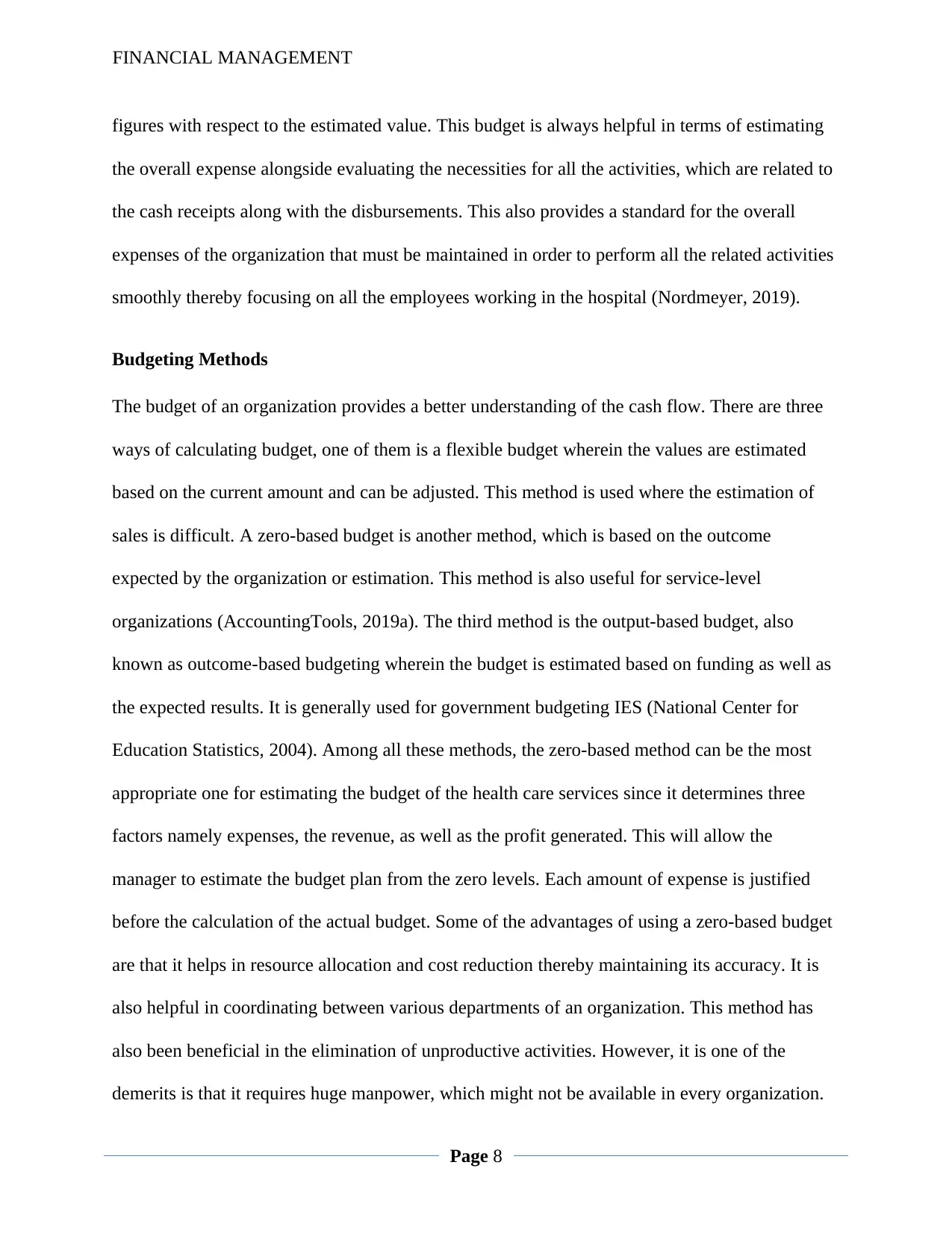
FINANCIAL MANAGEMENT
figures with respect to the estimated value. This budget is always helpful in terms of estimating
the overall expense alongside evaluating the necessities for all the activities, which are related to
the cash receipts along with the disbursements. This also provides a standard for the overall
expenses of the organization that must be maintained in order to perform all the related activities
smoothly thereby focusing on all the employees working in the hospital (Nordmeyer, 2019).
Budgeting Methods
The budget of an organization provides a better understanding of the cash flow. There are three
ways of calculating budget, one of them is a flexible budget wherein the values are estimated
based on the current amount and can be adjusted. This method is used where the estimation of
sales is difficult. A zero-based budget is another method, which is based on the outcome
expected by the organization or estimation. This method is also useful for service-level
organizations (AccountingTools, 2019a). The third method is the output-based budget, also
known as outcome-based budgeting wherein the budget is estimated based on funding as well as
the expected results. It is generally used for government budgeting IES (National Center for
Education Statistics, 2004). Among all these methods, the zero-based method can be the most
appropriate one for estimating the budget of the health care services since it determines three
factors namely expenses, the revenue, as well as the profit generated. This will allow the
manager to estimate the budget plan from the zero levels. Each amount of expense is justified
before the calculation of the actual budget. Some of the advantages of using a zero-based budget
are that it helps in resource allocation and cost reduction thereby maintaining its accuracy. It is
also helpful in coordinating between various departments of an organization. This method has
also been beneficial in the elimination of unproductive activities. However, it is one of the
demerits is that it requires huge manpower, which might not be available in every organization.
Page 8
figures with respect to the estimated value. This budget is always helpful in terms of estimating
the overall expense alongside evaluating the necessities for all the activities, which are related to
the cash receipts along with the disbursements. This also provides a standard for the overall
expenses of the organization that must be maintained in order to perform all the related activities
smoothly thereby focusing on all the employees working in the hospital (Nordmeyer, 2019).
Budgeting Methods
The budget of an organization provides a better understanding of the cash flow. There are three
ways of calculating budget, one of them is a flexible budget wherein the values are estimated
based on the current amount and can be adjusted. This method is used where the estimation of
sales is difficult. A zero-based budget is another method, which is based on the outcome
expected by the organization or estimation. This method is also useful for service-level
organizations (AccountingTools, 2019a). The third method is the output-based budget, also
known as outcome-based budgeting wherein the budget is estimated based on funding as well as
the expected results. It is generally used for government budgeting IES (National Center for
Education Statistics, 2004). Among all these methods, the zero-based method can be the most
appropriate one for estimating the budget of the health care services since it determines three
factors namely expenses, the revenue, as well as the profit generated. This will allow the
manager to estimate the budget plan from the zero levels. Each amount of expense is justified
before the calculation of the actual budget. Some of the advantages of using a zero-based budget
are that it helps in resource allocation and cost reduction thereby maintaining its accuracy. It is
also helpful in coordinating between various departments of an organization. This method has
also been beneficial in the elimination of unproductive activities. However, it is one of the
demerits is that it requires huge manpower, which might not be available in every organization.
Page 8
⊘ This is a preview!⊘
Do you want full access?
Subscribe today to unlock all pages.

Trusted by 1+ million students worldwide
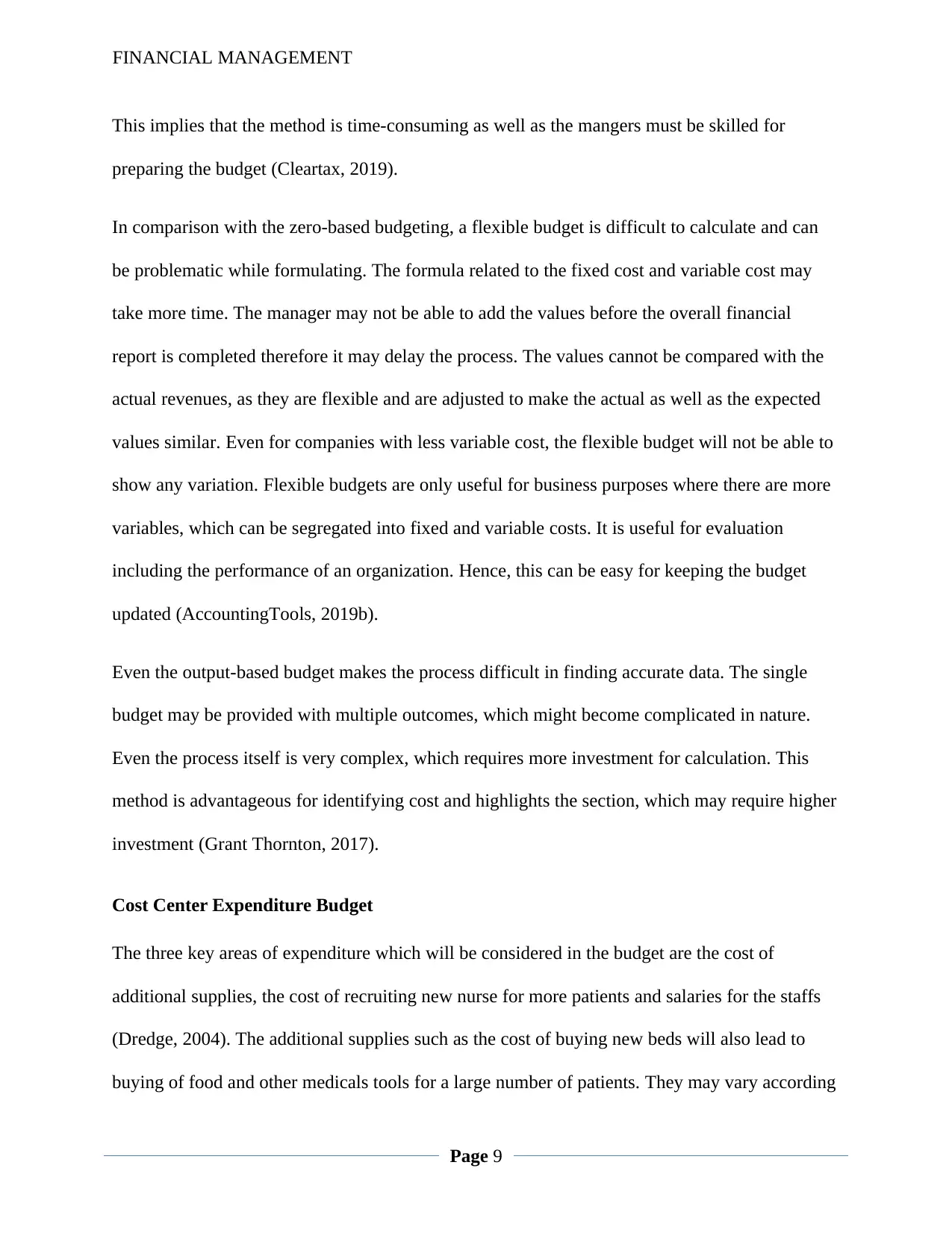
FINANCIAL MANAGEMENT
This implies that the method is time-consuming as well as the mangers must be skilled for
preparing the budget (Cleartax, 2019).
In comparison with the zero-based budgeting, a flexible budget is difficult to calculate and can
be problematic while formulating. The formula related to the fixed cost and variable cost may
take more time. The manager may not be able to add the values before the overall financial
report is completed therefore it may delay the process. The values cannot be compared with the
actual revenues, as they are flexible and are adjusted to make the actual as well as the expected
values similar. Even for companies with less variable cost, the flexible budget will not be able to
show any variation. Flexible budgets are only useful for business purposes where there are more
variables, which can be segregated into fixed and variable costs. It is useful for evaluation
including the performance of an organization. Hence, this can be easy for keeping the budget
updated (AccountingTools, 2019b).
Even the output-based budget makes the process difficult in finding accurate data. The single
budget may be provided with multiple outcomes, which might become complicated in nature.
Even the process itself is very complex, which requires more investment for calculation. This
method is advantageous for identifying cost and highlights the section, which may require higher
investment (Grant Thornton, 2017).
Cost Center Expenditure Budget
The three key areas of expenditure which will be considered in the budget are the cost of
additional supplies, the cost of recruiting new nurse for more patients and salaries for the staffs
(Dredge, 2004). The additional supplies such as the cost of buying new beds will also lead to
buying of food and other medicals tools for a large number of patients. They may vary according
Page 9
This implies that the method is time-consuming as well as the mangers must be skilled for
preparing the budget (Cleartax, 2019).
In comparison with the zero-based budgeting, a flexible budget is difficult to calculate and can
be problematic while formulating. The formula related to the fixed cost and variable cost may
take more time. The manager may not be able to add the values before the overall financial
report is completed therefore it may delay the process. The values cannot be compared with the
actual revenues, as they are flexible and are adjusted to make the actual as well as the expected
values similar. Even for companies with less variable cost, the flexible budget will not be able to
show any variation. Flexible budgets are only useful for business purposes where there are more
variables, which can be segregated into fixed and variable costs. It is useful for evaluation
including the performance of an organization. Hence, this can be easy for keeping the budget
updated (AccountingTools, 2019b).
Even the output-based budget makes the process difficult in finding accurate data. The single
budget may be provided with multiple outcomes, which might become complicated in nature.
Even the process itself is very complex, which requires more investment for calculation. This
method is advantageous for identifying cost and highlights the section, which may require higher
investment (Grant Thornton, 2017).
Cost Center Expenditure Budget
The three key areas of expenditure which will be considered in the budget are the cost of
additional supplies, the cost of recruiting new nurse for more patients and salaries for the staffs
(Dredge, 2004). The additional supplies such as the cost of buying new beds will also lead to
buying of food and other medicals tools for a large number of patients. They may vary according
Page 9
Paraphrase This Document
Need a fresh take? Get an instant paraphrase of this document with our AI Paraphraser
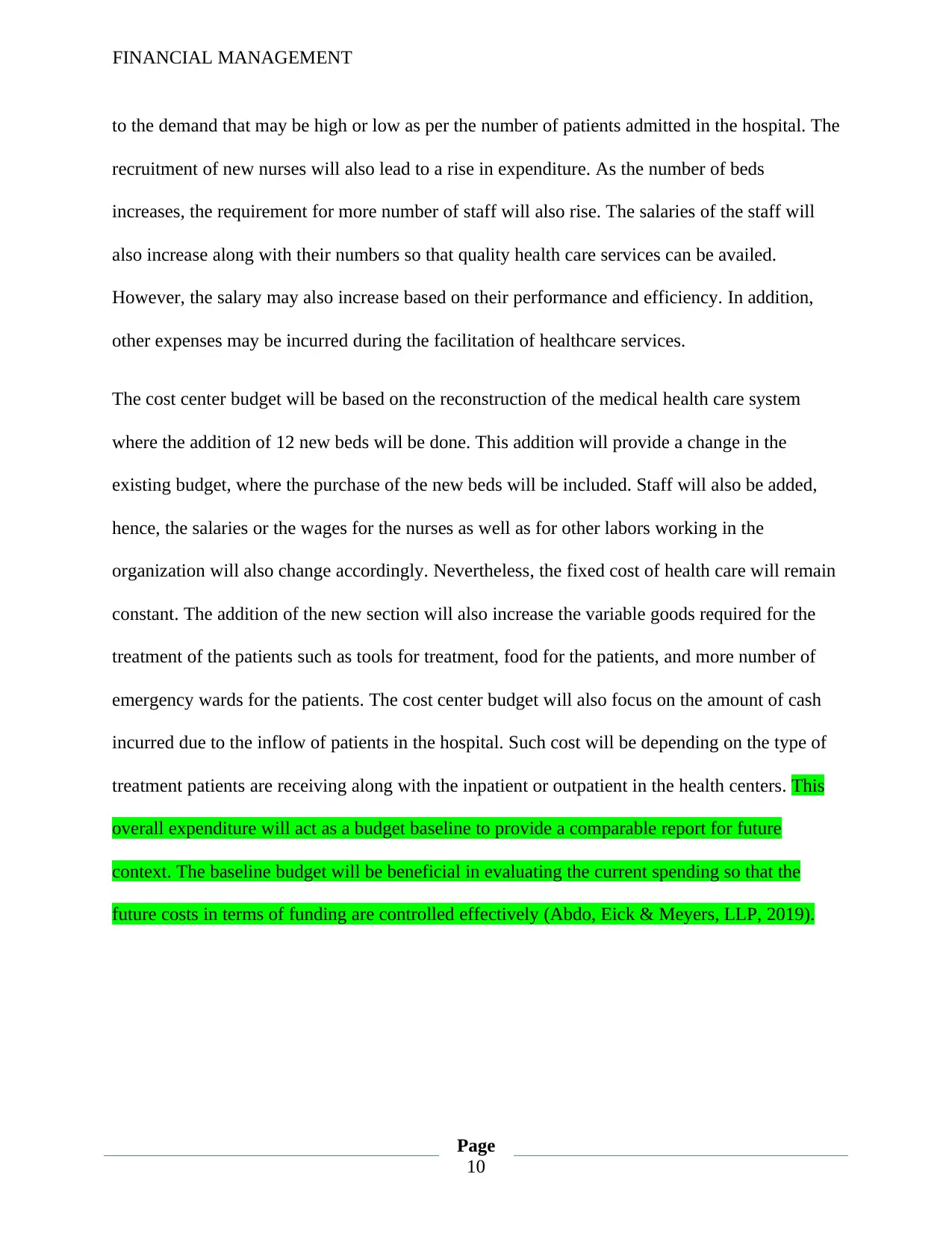
FINANCIAL MANAGEMENT
to the demand that may be high or low as per the number of patients admitted in the hospital. The
recruitment of new nurses will also lead to a rise in expenditure. As the number of beds
increases, the requirement for more number of staff will also rise. The salaries of the staff will
also increase along with their numbers so that quality health care services can be availed.
However, the salary may also increase based on their performance and efficiency. In addition,
other expenses may be incurred during the facilitation of healthcare services.
The cost center budget will be based on the reconstruction of the medical health care system
where the addition of 12 new beds will be done. This addition will provide a change in the
existing budget, where the purchase of the new beds will be included. Staff will also be added,
hence, the salaries or the wages for the nurses as well as for other labors working in the
organization will also change accordingly. Nevertheless, the fixed cost of health care will remain
constant. The addition of the new section will also increase the variable goods required for the
treatment of the patients such as tools for treatment, food for the patients, and more number of
emergency wards for the patients. The cost center budget will also focus on the amount of cash
incurred due to the inflow of patients in the hospital. Such cost will be depending on the type of
treatment patients are receiving along with the inpatient or outpatient in the health centers. This
overall expenditure will act as a budget baseline to provide a comparable report for future
context. The baseline budget will be beneficial in evaluating the current spending so that the
future costs in terms of funding are controlled effectively (Abdo, Eick & Meyers, LLP, 2019).
Page
10
to the demand that may be high or low as per the number of patients admitted in the hospital. The
recruitment of new nurses will also lead to a rise in expenditure. As the number of beds
increases, the requirement for more number of staff will also rise. The salaries of the staff will
also increase along with their numbers so that quality health care services can be availed.
However, the salary may also increase based on their performance and efficiency. In addition,
other expenses may be incurred during the facilitation of healthcare services.
The cost center budget will be based on the reconstruction of the medical health care system
where the addition of 12 new beds will be done. This addition will provide a change in the
existing budget, where the purchase of the new beds will be included. Staff will also be added,
hence, the salaries or the wages for the nurses as well as for other labors working in the
organization will also change accordingly. Nevertheless, the fixed cost of health care will remain
constant. The addition of the new section will also increase the variable goods required for the
treatment of the patients such as tools for treatment, food for the patients, and more number of
emergency wards for the patients. The cost center budget will also focus on the amount of cash
incurred due to the inflow of patients in the hospital. Such cost will be depending on the type of
treatment patients are receiving along with the inpatient or outpatient in the health centers. This
overall expenditure will act as a budget baseline to provide a comparable report for future
context. The baseline budget will be beneficial in evaluating the current spending so that the
future costs in terms of funding are controlled effectively (Abdo, Eick & Meyers, LLP, 2019).
Page
10
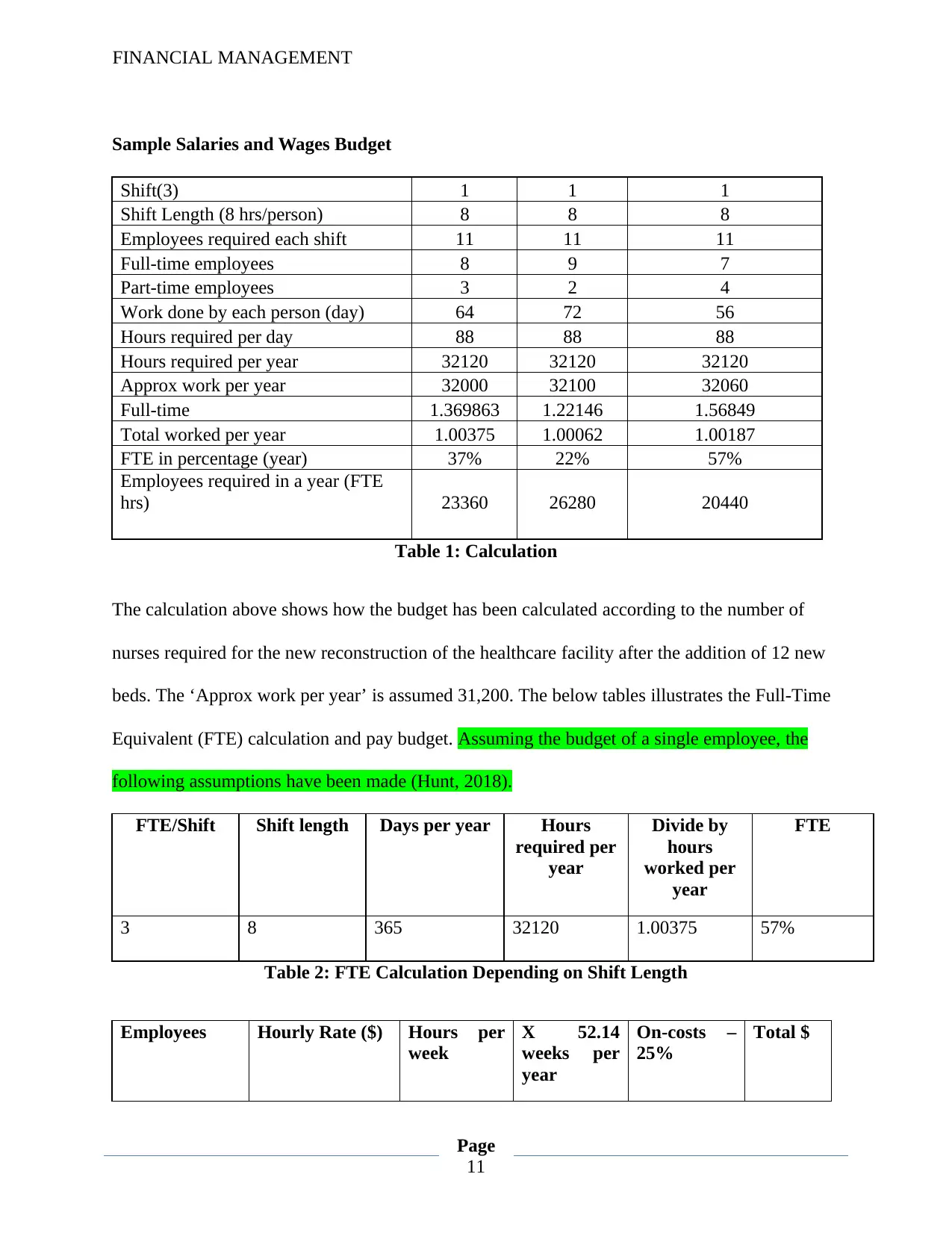
FINANCIAL MANAGEMENT
Sample Salaries and Wages Budget
Shift(3) 1 1 1
Shift Length (8 hrs/person) 8 8 8
Employees required each shift 11 11 11
Full-time employees 8 9 7
Part-time employees 3 2 4
Work done by each person (day) 64 72 56
Hours required per day 88 88 88
Hours required per year 32120 32120 32120
Approx work per year 32000 32100 32060
Full-time 1.369863 1.22146 1.56849
Total worked per year 1.00375 1.00062 1.00187
FTE in percentage (year) 37% 22% 57%
Employees required in a year (FTE
hrs) 23360 26280 20440
Table 1: Calculation
The calculation above shows how the budget has been calculated according to the number of
nurses required for the new reconstruction of the healthcare facility after the addition of 12 new
beds. The ‘Approx work per year’ is assumed 31,200. The below tables illustrates the Full-Time
Equivalent (FTE) calculation and pay budget. Assuming the budget of a single employee, the
following assumptions have been made (Hunt, 2018).
FTE/Shift Shift length Days per year Hours
required per
year
Divide by
hours
worked per
year
FTE
3 8 365 32120 1.00375 57%
Table 2: FTE Calculation Depending on Shift Length
Employees Hourly Rate ($) Hours per
week
X 52.14
weeks per
year
On-costs –
25%
Total $
Page
11
Sample Salaries and Wages Budget
Shift(3) 1 1 1
Shift Length (8 hrs/person) 8 8 8
Employees required each shift 11 11 11
Full-time employees 8 9 7
Part-time employees 3 2 4
Work done by each person (day) 64 72 56
Hours required per day 88 88 88
Hours required per year 32120 32120 32120
Approx work per year 32000 32100 32060
Full-time 1.369863 1.22146 1.56849
Total worked per year 1.00375 1.00062 1.00187
FTE in percentage (year) 37% 22% 57%
Employees required in a year (FTE
hrs) 23360 26280 20440
Table 1: Calculation
The calculation above shows how the budget has been calculated according to the number of
nurses required for the new reconstruction of the healthcare facility after the addition of 12 new
beds. The ‘Approx work per year’ is assumed 31,200. The below tables illustrates the Full-Time
Equivalent (FTE) calculation and pay budget. Assuming the budget of a single employee, the
following assumptions have been made (Hunt, 2018).
FTE/Shift Shift length Days per year Hours
required per
year
Divide by
hours
worked per
year
FTE
3 8 365 32120 1.00375 57%
Table 2: FTE Calculation Depending on Shift Length
Employees Hourly Rate ($) Hours per
week
X 52.14
weeks per
year
On-costs –
25%
Total $
Page
11
⊘ This is a preview!⊘
Do you want full access?
Subscribe today to unlock all pages.

Trusted by 1+ million students worldwide
1 out of 17
Related Documents
Your All-in-One AI-Powered Toolkit for Academic Success.
+13062052269
info@desklib.com
Available 24*7 on WhatsApp / Email
![[object Object]](/_next/static/media/star-bottom.7253800d.svg)
Unlock your academic potential
Copyright © 2020–2025 A2Z Services. All Rights Reserved. Developed and managed by ZUCOL.





